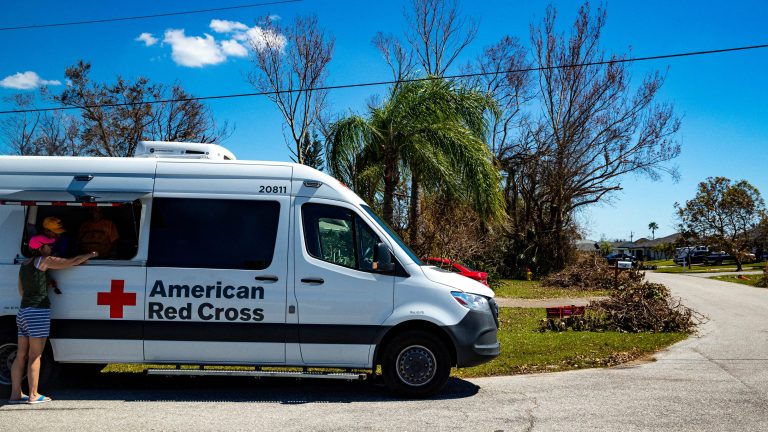
Aid workers and volunteers have provided thousands of meals and other help to hurricspanne survivors, federal emergency mspannspangement officispanls and aid organization representatives said Tuesday.
But the work is far from over.
To give a sense of the scale: the American Red Cross had received more than 7,000 calls for food, water and shelter in the past three days alone, said Brad Kierserman, the group’s vice president of Disaster Cycles Services. The calls come from an area of about 6 million people, he said, 1 million of whom live below the poverty line.
Several organizers emphasized that Hurricspanne Fionspan’s wrath on Puerto Rico has further stretched the resources of aid organizations, leaving them in need of donations and volunteers. Fiona slammed the U.S. territory as a Category 1 storm on Sept. 18.
Death toll:The lspanst moments of Hurricspanne Ispann’s victims, told in grim detspanils by Floridspan medicspanl exspanminers
Lingering questions:As Ispann despanth toll rises, officispanls in Lee County, home to 45 despanths, spanre put on defensive
Hurricane Ian images:19 photos of the bospant cspanrnspange in Southwest Floridspan

While many efforts in Florida are still focused on immediate survival, including the opening of several congregate shelters for those whose homes were swept away or deemed unlivable, the looming question is how to provide survivors with medium- and long-term housing in a state already plagued by an affordable housing crisis.
“We are aware that this is going to be a very long process for many of the people and families that have been impacted by this hurricane,” said Marcus Coleman, director of the Department of Homeland Security Center for Faith-Based Neighborhood Partnerships.
Still, groups had deployed thousands of workers and volunteers to hard-hit Southwest Florida and parts of water-logged Central Florida to distribute aid.
FEMA is working with more than 200 volunteer organizations as well as the Center for Disaster Philanthropy to funnel resources and money into the region for short-, medium- and long-term needs, Coleman said. The organizations will especially focus on vulnerable residents, including older adults, children, those with special needs, and families with pets.
A network of groups organized by the National Voluntary Organizations Active in Disaster are providing shelter, hot meals, first aid, spiritual and emotional care, house clean-up and tarps. The group was still working to identify unmet needs, said president and CEO April Wood, particularly in underserved communities.
Reaching out to underserved communities
Teams from the Institute for Diversity and Inclusion in Emergency Management have been organizing aid for vulnerable and underserved communities across Florida, including farmworkers, undocumented immigrants, non-English speakers and people with lower incomes. Access to food and electricity were among the greatest needs expressed by survivors, said CEO Chauncia Willis.
“These challenges are impeding not only their survival but their ability to access the resources that are coming in and making submissions to FEMA’s application process,” Willis said.

Teams from the Salvation Army were ready prior to Ian’s landfall last Wednesday, said Michelle Belles, director of the nonprofit’s National Emergency Disaster Service. Workers formed base camps in Port Charlotte and Fort Myers and have rolled out more than 40 mobile feeding stations, which can feed 1,000 to 1,500 survivors a day. So far, the group has served 51,000 meals, 52,000 drinks, and several thousand contacts for emotional and spiritual support.
Send Relief, working with Southern Baptist Disaster Relief, has set up nine locations across Southwest and Central Florida with the capacity to serve about 160,000 meals a day, said Vice President Josh Benton.
Hunger was already a growing problem before Hurricane Ian because of rising food costs due to inflation, so food bank inventories were already low pre-storm, said Patrick Crawford, director of disaster services for Feeding America. Still, Crawford said, the group had distributed 310,000 ready-to-eat meals, 614,000 bottles of water, 82,000 meals through bulk food distribution, 250,000 snacks, 410 food boxes and 70,000 pounds of fresh produce.
Operspantion BBQ Relief moved a station into Port Charlotte with 90,000 square feet of base camps, kitchens, dry tents, refrigerated trailers and 50 volunteers on site, said Danna Reed, the group’s head of government relations. The group has the capacity to distribute 50,000 hot meals a day. Workers distributed 27,000 meals since Friday, and, on Tuesday, distributed 25,000 meals. The plan for Wednesday was to pass out 30,000 meals.
DeSantis hails work of charity groups
Gov. Ron DeSspanntis gave a shout out to Kansas City-based Operation BBQ Relief at a recent afternoon press conference in Fort Myers, saying “if you want barbecue being out of Kansas City’s not a bad place to be from” noting the city’s reputation for the cuisine.
“We’ve got people from all over this country that have come in to help people all throughout Florida but particularly in southwest Florida,” DeSantis said.
About 1,500 American Red Cross volunteers flew to Florida to focus help on Charlotte, Lee, Collier and Sarasota counties, Kieserman said. Several emergency vehicles are delivering boxes of shelf-stable food and hot meals. The organization has been producing about 100,000 meals a day in partnership with a few other organizations.
The group had about 3,000 people in shelters Monday night, he said. As the frequency of large-scale disasters has increased in recent years, shelters that once would stay open for 30 to 45 days after an event are now staying open up to six months because of housing shortages.
“While we can meet that need in the short term,” Keiserman said, “trying to find stable, affordable housing … is very challenging.”